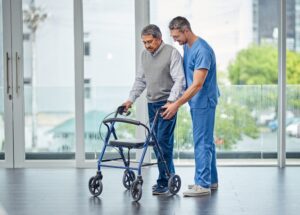
Nursing homes are required to have safety measures such as fall detection systems, non–slip flooring, and appropriately placed handrails to help prevent falls. In addition, staff training and suitable care planning can help residents avoid falls and other accidents.
Residents with mobility limitations or cognitive impairments are especially vulnerable to falls. To minimize this risk, nursing homes must focus not only on creating a safe physical environment but also on implementing resident-specific safety measures.
If your loved one has experienced a fall in a nursing home, our Atlanta nursing home abuse lawyers may be able to help. Our team has recovered millions for injured nursing home residents and their families. Call today for a free consultation.
Important Environmental Safety Measures
Effective safety measures in a nursing home begin with creating a secure environment for all residents, whether they are ambulatory or use wheelchairs. Nursing homes are required to implement several key safety protocols, which typically include:
- Clear Pathways: Hallways, rooms, and common areas must be kept free of obstacles such as loose rugs, electrical cords, and any clutter that could pose a tripping hazard.
- Non–Slip Flooring: Floors should be designed to prevent slipping, particularly in high-risk areas like bathrooms, kitchens, and hallways.
- Adequate Lighting: Staff must provide proper lighting throughout the facility, paying special attention to areas like hallways, staircases, and bathrooms. Nightlights in resident rooms and bathrooms can further help residents navigate safely at night.
- Handrails and Grab Bars: Handrails should be installed in hallways, bathrooms, and staircases to assist residents with mobility. Grab bars in showers, near toilets, and in other critical areas can help residents maintain their balance.
- Elevator Access: In multi-story buildings, elevators must be easily accessible, with reliable safety features to ensure safe operation and prevent accidents.
Resident-Specific Safety Measures
Nursing homes are required to have safety measures specific to each resident. Facilities typically hold quarterly care plan meetings where family members may attend, and staff make care-related decisions.
However, if a fall or other safety issue occurs, meetings could be more frequent.
Fall Risk Assessments
Residents should undergo regular fall risk assessments upon admission and periodically throughout their stay. These assessments review factors like the resident’s mobility, balance, medications, vision, cognitive state, and fall history.
Some medications, particularly sedatives, antidepressants, and antihypertensives, can increase fall risk by causing dizziness or affecting balance. Nursing homes are required to review residents’ medications regularly to minimize fall risks.
Personalized Fall Prevention Plans
After evaluating each resident’s fall risk, nursing home staff must develop a personalized care plan that includes specific interventions to reduce the likelihood of falls. These may involve providing mobility aids or assisting residents with daily activities.
Staff must supply appropriate assistive devices, such as walkers, canes, or wheelchairs, to residents who need them. They must also ensure these devices are in good condition and properly fitted for safe use.
After a resident experiences a fall, the nursing home must reassess the care plan, identify any new risk factors, and update interventions as needed.
The Role of Physical Therapy
Physical therapy programs are important for helping residents maintain or improve their mobility, which significantly reduces the risk of falls.
Physical therapy staff play a major role in assessing each resident’s fall risk, determining the appropriate level of assistance, and ensuring proper fitting and use of mobility aids such as walkers, canes, and wheelchairs.
The physical therapy department can also help train staff on how to assist residents safely, use mobility aids correctly, and identify environmental hazards that might lead to falls.
Monitoring and Supervision
Staff must closely monitor residents at higher risk of falls, especially those with cognitive impairments such as dementia. They should assist with mobility or transfers as needed to prevent accidents.
Nursing homes must maintain adequate staff–to–resident ratios to ensure quality care and resident safety. Facilities that fail to meet these staffing standards may face sanctions, including fines, penalties, or loss of licensure.
For residents at high risk of falling, particularly those with cognitive impairments, nursing homes can install bed or chair alarms. These devices alert staff when a resident tries to get up without help, allowing them to intervene and prevent a potential fall.
Regulations and Standards for Nursing Homes
Nursing homes must adhere to federal and state regulations to ensure fall prevention safety measures are properly implemented. The Centers for Medicare & Medicaid Services has specific guidelines for fall prevention in nursing homes under the Nursing Home Reform Act.
In Georgia, the Healthcare Facility Regulation Division of the Department of Community Health inspects nursing homes and ensures they comply with required safety measures. They are your resource for filing a complaint if necessary.

What to Do if Your Loved One Is Hurt in a Nursing Home Fall
The safety measures nursing homes are required to have are meant to reduce the chance of a fall. By combining environmental modifications, resident-specific care plans, staff training, and continuous monitoring, they are often effective.
However, when a negligent nursing home or its staff creates a dangerous situation that causes a fall, you can take action. Schenk Nursing Home Abuse Law can help you hold the facility accountable.
Call today for a free consultation and tell us what happened.




